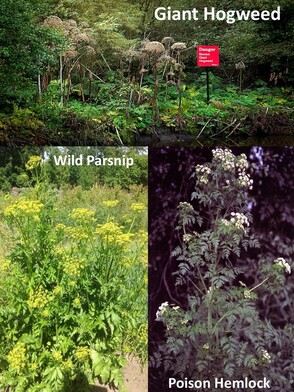CONSERVATION CORNER
A weekly blog for all things conservation
 By: Dan Rhodes, Education Coordinator In many cases, we here at the Conservation District frown on making blanket statements that describe surprisingly beneficial native wild plants as weeds when they often have important roles to play in the environment. A ‘weed’ plant after all is simply a plant growing on the landscape where it’s unwanted from a human perspective. Many beneficial wildflowers such as goldenrod, New England Aster, jewelweed, ragweed, boneset, Joe-Pye weed, daisy flea-bane and many others, are often removed by private property owners without hesitation in favor of ornamental flowers and plants they deem to be more aesthetically pleasing. The problem with this kind of thinking is that these so-called ‘weed’ plants are incredibly important sources of highly nutritious food for wildlife like deer and as sources of nectar and pollen at critical times for pollinators like honeybees. This all being said, there are dozens of species of invasive plants that are NEVER going to be beneficial in any scenario if they are found growing in Bradford County. Besides having the ability to invade fields, forests, stream-side riparian zones, wetlands and other environments while degrading wildlife habitat and land values, the three true weed species I wanted to highlight in this article (wild parsnip, giant hogweed and poison hemlock) also pose considerable risk to human and livestock health. Both giant hogweed and wild parsnip contain toxic sap inside their stems, leaves, roots, and seeds that make human and/or livestock skin extremely sensitive to ultraviolet light. Any exposed skin in contact with sap from either plant should be washed and covered immediately and medical attention sought if burning skin rashes appear. Severe exposure to this toxic sap can even create permanent scarring and blindness! As you can imagine, this makes cutting, treating, pulling, or otherwise eliminating these invasive plants dangerous to humans and animals, as mowing the plants can spray the toxic sap all over the place, spread seeds to new areas and require special protective clothing and tools. For these reasons, if you find an infestation of giant hogweed or wild parsnip on your property, DO NOT TOUCH THE PLANTS! Successful eradication efforts might involve a combination of treatment options over a period of time, so please seek assistance from your local Extension, Conservation District or Bureau of Forestry personnel for guidance.
In addition to the potential for dangerous skin burns in humans and livestock, there are also risks associated with livestock consumption of the plants. Poison hemlock, is deadly if consumed wet or dry-baled in hay. Conflicting information exists whether wild parsnip and giant hogweed are a risk for livestock consumption, as some sources say these plants pose little risk while other sources state they are very toxic if consumed. Please consult a Penn State Extension professional for more detailed guidance on grazing risks associated with these plants if you find them on your farm. While giant hogweed’s existence in Bradford County is poorly documented, the existence of wild parsnip and poison hemlock outbreaks are obvious and concerning. Nearly every roadside ditch, fallow hay-field or abandoned brush lot are loaded with wild parsnips; easily spotted this time of year with their yellow flower tops. I also personally stumbled on a dense stand of poison hemlock in the Canton area that I had not seen in previous years along a stream bank near the high school. Regardless of whether you currently have these concerning pest plants on your property or not, please take note of how to identify them and take the appropriate steps in conjunction with professional assistance, to address any future outbreaks of them on your property if they occur. It is always much easier to get quick control of a few isolated individuals in the beginning, rather than dealing with a massive horde of them years after they get established. The health, productivity and natural beauty of Bradford County depends on proactive and wise management of serious weed problems such as these. The Bradford County Conservation District is committed to helping people manage resources wisely. You can visit the Bradford County Conservation District at 200 Lake Rd in Wysox across from the Wysox Fire Hall. Contact us at (570) 485-3144 or visit our web page at www.bccdpa.com.
0 Comments
Leave a Reply. |
AuthorsVarious staff at the Bradford County Conservation District Archives
July 2024
Categories
All
|
|
Bradford County Conservation District
Stoll Natural Resource Center 200 Lake Road, Suite E | Towanda PA 18848 Phone: (570)-485-3144 |
